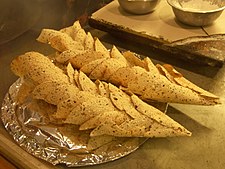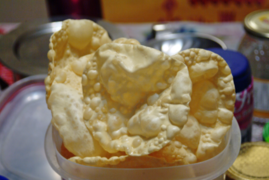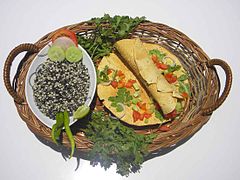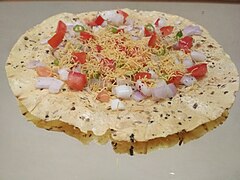Papadam
 Fire-toasted papadam | |
| Alternative names | Papar, appadam, pampas, happala, poppadam, poppadom, appalam, pappadam, puppodum, pappadum, pomperdom, pompadom |
|---|---|
| Place of origin | Indian subcontinent |
| Region or state | Indian subcontinent with region variations |
| Main ingredients | Flour from lentils, black gram, chickpeas, potato or rice |
| Variations | Rice, tapioca (sabudana), or potato papar, masala papar, garlic papar, ginger papar |
A papadam, or appalam is a seasoned flatbread made from dried dough of black gram bean flour, either fried or cooked with dry heat (flipped over an open flame) until crunchy. Other flours made from lentils, chickpeas, rice, tapioca, millet or potato are also used. Papadams are typically served as an accompaniment to a meal in India, Pakistan, Bangladesh, Nepal and Sri Lanka or as an appetiser, often with a dip such as chutneys or toppings such as chopped onions and chillies, or they may be used as an ingredient in sabjis.
Etymology[]
Papadam is derived from the Sanskrit word parpaṭa (पर्पट), meaning a flattened disc.[citation needed] In other districts they are known by several names, e.g. appalam in Tamil Nadu, happala in Karnataka, pappadam in Kerala, appadam in Andhra/Telangana, papad in Maharashtra,[1] Punjab and Gujarat, pampada in Odisha.[citation needed]
Regional variations[]
This section does not cite any sources. (March 2019) |


Papadam recipes vary from region to region and from family to family. They are typically made from a flour or paste derived from lentils, chickpeas, black gram, rice, or potatoes.
Salt and peanut oil are added to make a dough, which can be flavored with seasonings such as chili, cumin, garlic, or black pepper. Sometimes, baking soda or slaked lime or also added. The dough is shaped into a thin, round flatbreads, dried, (traditionally in the sun), and can be cooked by deep frying, roasting over an open flame, toasting, or microwaving, depending on the desired texture.
Bikaner is the hub of chickpea and green gram papadam manufacturing. Potato papadam is made in Varanasi. Most sweet- and snack-selling national companies are also involved in this business. In the north, papads made in the city of Amritsar and its surrounds (Amritsari Papar Warian) are especially famous. The Lijjat Papad company (Shri Mahila Griha Udyog Lijjat Papad), headquartered in Mumbai, is a major manufacturer, and is often cited as an exemplar of the women's empowerment movement in India, as it is run entirely by women.
In most Indian restaurants around the world, they are served as an appetizer with dips, which often include mango chutney, lime pickle, onion chutney, and raita. Masala papar with sev, onion, tomato and coriander leaves is one of India's most popular appetizers.
Ingredients and preparation[]
Papadam can be prepared from different ingredients and methods. Arguably, the most popular recipe uses flour ground from hulled split black gram[2] mixed with black pepper, salt, and a small amount of vegetable oil and a food-grade alkali, and the mixture is kneaded. A well-kneaded dough is then flattened into very thin rounds and then dried and stored for later preparation and consumption. It may also contain rice, Jackfruit, Sabudana, etc., as main ingredients. Cracked black pepper, red chili powder, Asafoetida, or cumin or sesame seeds are often used as flavoring agents. Papar or Happala is also made from Rice flakes, Ragi and Horsegram also.[3]
Business[]
In India papadams are manufactured in Madurai, Kanchipuram, and Chennai in Tamil Nadu, Punjab, Rajasthan, Maharastra and Gujarat; Guruvayur, Palakkad, Thiruvanathapuram in Kerala; Madurai is the origin for appalam / papadams.
Papadam is often associated with the empowerment of women in India.[4] Many individual and organized businesses run by women produce papad, pickles, and other snacks. This provides them regular income from minimal financial investments. Shri Mahila Griha Udyog Lijjat Papad is an organization (owned and run solely by women) which produces large quantities of papadams on the open market, which started as a small business in the late 1950s,[5][6] with an annual income in 2005 of about ₹6.5 billion (equivalent to ₹18 billion or US$250 million in 2019). However, with the recent growth of modern trade in India and the growing consumer awareness, other brands have been gaining in popularity within this category.
Spelling and pronunciation[]
Some divergence of transliteration may be noted in the third consonant in the Hindi/Urdu word pāpaṛ. The sound is the retroflex flap [ɽ], which is written in Hindi with the Devanagari letter ड़, and in Urdu script with the Perso-Arabic letter ڑ. Although in ISO 15919 the Hindi letter ड़ is transliterated as <ṛ>, popular or nonstandard transliterations of Hindi use <d> for this sound. The occurrence of this consonant in the word pāpaṛ has given rise to two alternative spellings in English: papar (anglicized as "popper"), which reflects its phonology, and papad, which reflects its etymology.
Gallery[]

Tamil Appalam

A stack of roasted papadams, ready to be served

Rice papadam

Uradal papadam

Toasted papadam served with dal and rice

Fire-toasting papadam

Masala papar

Raw jacfruit papad in coastal Karnataka
See also[]
- Indian bread – Wide variety of flatbreads and crêpes which are an integral part of Indian cuisine
- Sandige – Fried snack, originating from the Indian subcontinent
References[]
- ^ Renu Khedkar, Pratima Shastri , Amarinder Singh Bawa. "Standardization, Characterization and Shelf Life Studies on Sandge, a Traditional Food Adjunct of Western India" (PDF). International Journal of Environment, Agriculture and Biotechnology (IJEAB) – via ijeab.CS1 maint: multiple names: authors list (link)
- ^ J. Smartt; Emmanuel Nwokolo (6 December 2012). Food and Feed from Legumes and Oilseeds. Springer Science & Business Media. p. 28. ISBN 978-1-4613-0433-3.
- ^ "Poha papad,Rice flakes Papad, Summer Recipe". Udupi-Recipes. Retrieved 9 January 2020.
- ^ World Bank. "Empowering Women in Urban India: Shri Mahila Griha Udyog Lijjat Papad" (PDF). Empowerment Case Studies. World Bank. Retrieved 23 September 2012.
- ^ Malathi Ramanathan. "Grassroots Developments in Women's Empowerment in India: Case Study of Shri Mahila Griha Udyog Lijjat Papad (1959–2000)" (PDF). Archived from the original (PDF) on 15 March 2007. Retrieved 15 January 2007.
- ^ "organization - The Beginning". Lijjat. Archived from the original on 27 September 2007. Retrieved 4 February 2006.
External links[]
 Media related to Papadams at Wikimedia Commons
Media related to Papadams at Wikimedia Commons
- Indian snack foods
- Pakistani breads
- Pakistani fast food
- Indian breads
- Flatbreads
- Unleavened breads
- Indian fast food
- Tamil cuisine
- Kerala cuisine
- Indian legume dishes
- Karnataka cuisine
- Telangana cuisine
- Andhra cuisine
- Sri Lankan legume dishes














